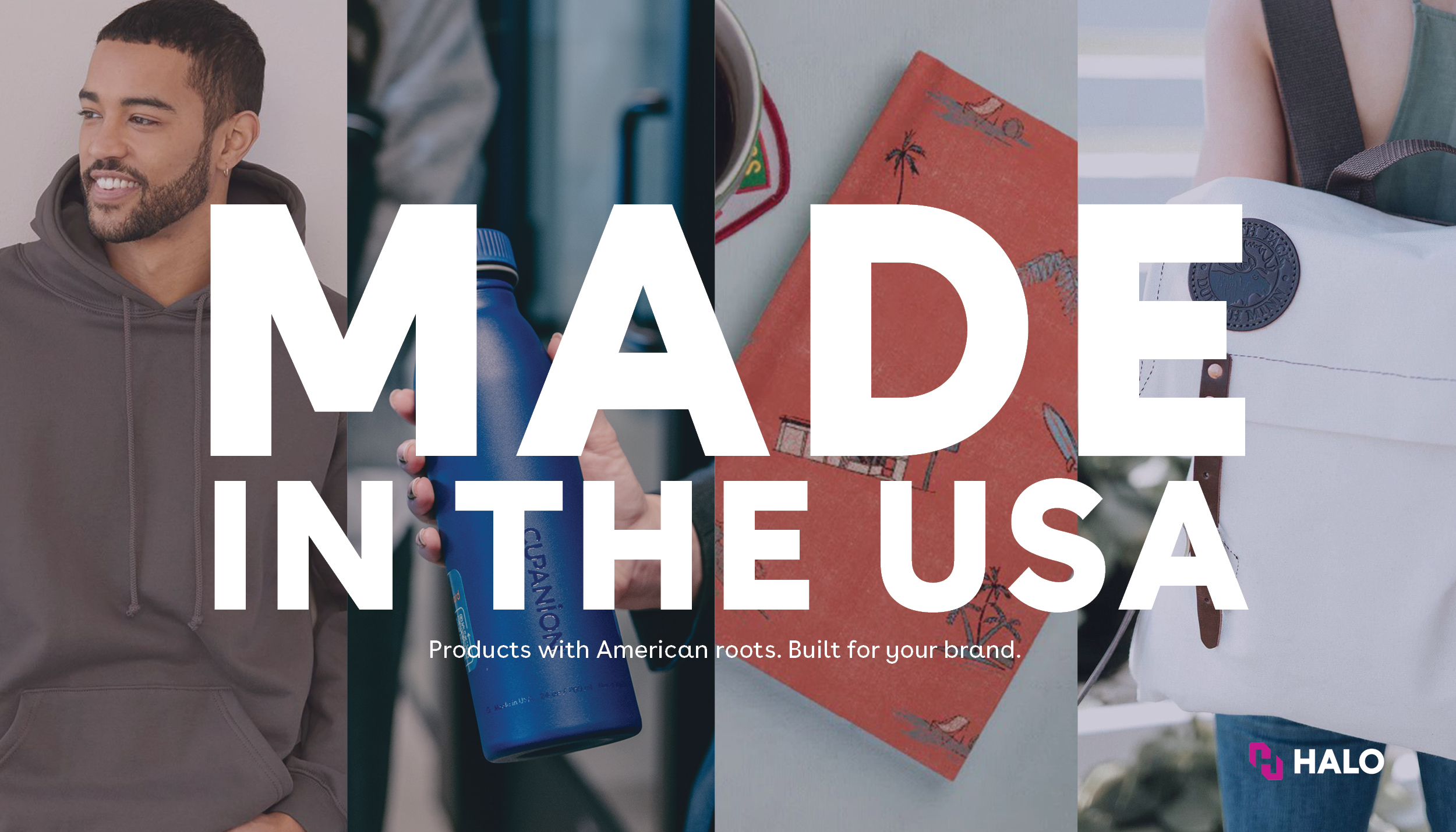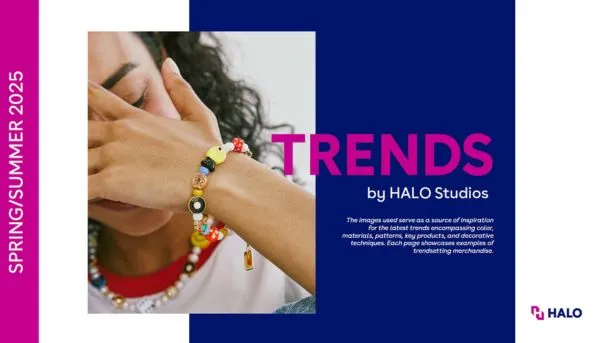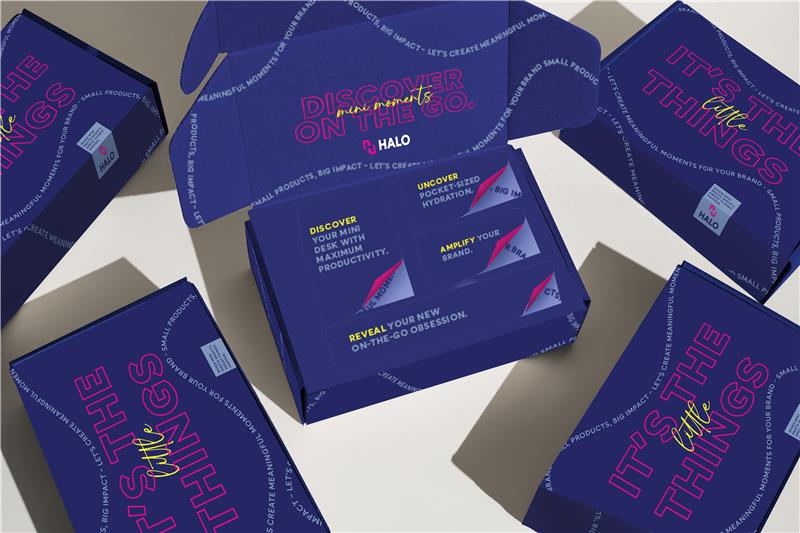Summary
In 2021, The IRF conducted an online survey of 1,018 workers, complementing the survey data with aggregate redemption data from several points platform providers. The research also included interviews with ten experts who design and measure employee points rewards programs for hundreds of customers. A thorough review of existing academic research and articles on the topic was also conducted.
This IRF paper explores the prevalence, perceptions, and motivational impact of workplace redeemable points rewards or ‘awards,’ (hereafter, “points rewards”). Specifically, we survey employees, review the existing literature, and interview point program users and managers to understand how employees perceive, collect, and redeem points, and how participating in point programs affects employee engagement, intrinsic motivation, and identification with the organization.
From the survey, the IRF found that for each individual statement and on average across all statements, respondents that work for organizations that use a points reward program (versus no points program) report:
- Higher intrinsic motivation
- Higher organizational identification
- Higher employee engagement
- Greater satisfaction with their rewards and recognition
- Greater preference for working for an organization with a points reward program
From the literature review and expert interviews, the IRF found that points rewards participants:
- Care more about the recognition, appreciation, and belonging associated with receiving points rewards than what the what the points are redeemed for
- Find points themselves memorable (e.g., “points feel like gifts”)
- May spend or save their points; use them for big or small dollar items, but receiving the points themselves delivers part of the reward (and the positive effects that follow)
Introduction: The Efficacy of Employee Points-Based Reward Programs
Critics of employee points reward programs argue that the programs are transactional – they encourage redemption for utilitarian items, making the rewards unmemorable. Skeptics warn that in points reward programs, the separation between receiving recognition and redeeming the reward is problematic because it might take employees weeks or months to accumulate enough points to obtain a reward. This, they believe, results in weak links between desired behaviors and the reward. Finally, detractors argue that millions of points go unredeemed in organizations, which suggests that employees do not care a great deal about acquiring them.[i]
While research into consumer points reward programs abounds, virtually no academic work has been published on the efficacy of employee points-reward programs. Thus, proponents, skeptics, and detractors of these programs tend to rely on their own observations, and, perhaps, their biases for or against point rewards.
The average consumer has signed up for more than seventeen different loyalty programs but are maybe actively engaged in five.
— Expert IntervieweeIn the customer loyalty world, points programs have existed for decades. They continue to proliferate, providing very powerful evidence of their effectiveness. Yet, after examining dozens of programs over several years, the authors of a 2006 study concluded: “Even as loyalty programs are launched left and right, many are being scuttled, and not with a sense of mission accomplished.”[ii] Fifteen years and thousands of new consumer points programs later, it is difficult to imagine that customer cynicism toward loyalty points programs has receded, yet these programs show no sign of leaving the scene.
Whether and what parallels exist between consumer and employee points rewards programs is a question for another paper. But where researchers have explored employee points reward programs, they have found that participants plan for their reward significantly ‘more’ than cash or gift card recipients, resulting in greater satisfaction with the reward. Research suggests that points reward earners are more likely than cash recipients to talk about the rewards they receive and are significantly more satisfied with their rewards than gift card recipients.[iii]
In an experiment at Goodyear Tires some years ago, a group of salespeople was arbitrarily chosen to receive monetary rewards. A second group was enrolled in a points reward program featuring a selection of merchandise and travel rewards. In both cases, salespeople earned rewards for every increment of 12 tires sold. The experiment ran for six months, during which the points reward group outperformed the cash reward group by 46%. The points group also sold a much more diverse mix of products and generated greater ROI than the cash reward group. For every dollar invested by Goodyear in the program, the points group returned $1.31, whereas the cash group, returned on just 80 cents.[iv]
I think we have to consider that the great thing about points is they are not as brutal as cash. You can figure out the cash value of points, but you still get more emotional impact. In fact, you get it twice – when someone gives you the points and when you redeem them.
— Expert IntervieweeGiven the lack of investigation into the efficacy and psychology of employee points reward programs to date, the Incentive Research Foundation (IRF) conducted an online survey of 1,018 workers currently employed at an organization. The survey data was complemented with actual (aggregate) redemption data from several points platform providers and a thorough review of existing academic research and articles on the topic. The IRF also interviewed ten experts who design and measure employee points rewards programs for hundreds of customers (combined).[1]
Points Versus No Points: Impact on Intrinsic Motivation Organization Identification, and Employee Engagement
Seventy-nine percent of the online respondents reported that they currently work for an employer that uses a points program whereas 21 percent reported that their employer does not use a points program. We examined whether respondents’ intrinsic motivation, organization identification, and employee engagement differs between those who work for an organization that uses a points reward program and those who do not. For each individual statement and on average across all statements, respondents that work for organizations that use a points reward program reported more favorable ratings than those that work for an organization that does not use a point program. See Appendix A for additional findings related to intrinsic motivation, organization identification, and employee engagement.
Intrinsic Motivation: Self-Determination
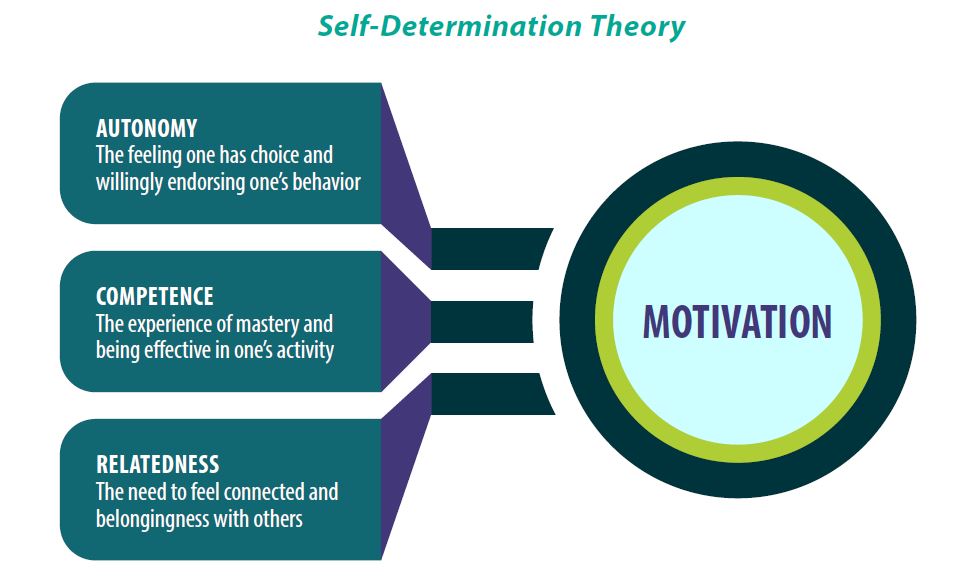
First, we explored employees’ intrinsic motivation through the lens of Self-Determination Theory (SDT).[v]
- SDT explains employees’ intrinsic motivation as a function of three basic needs: a sense of autonomy, a sense of competence, and a sense of relatedness (social connection).
- We asked respondents to report their level of agreement with nine statements on a 7-level Likert Scale (Strongly Disagree to Strongly Agree).
- The positive association between points and SDT is greater for employees with less work experience than more work experience.
- SDT results hold across all income ranges, part-time vs. full-time status, and years with the same employer.
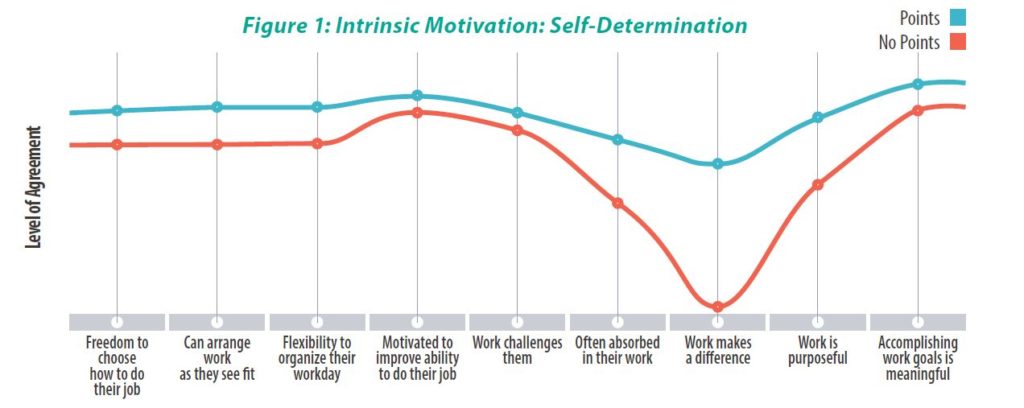
Organizational Identification
- Employees’ organizational identification is broadly defined as the psychological phenomenon whereby employees define themselves by their employment at a particular organization.
- Organizational identification is largely associated with positive firm outcomes such as less managerial myopia, less opportunistic reporting, and greater employee performance.
- The positive association between points and organizational identification is greater for employees with less work experience than more work experience and greater for smaller organizations (<100 employees) than bigger organizations (>100 employees).
- Identification results hold across all income ranges, part-time vs. full-time status, and years with the same employer.

Employee Engagement
- Employee engagement refers to the extent to which employees simultaneously dedicate physical, cognitive, and emotional energy towards their work.
- Employee engagement is found to be associated with many positive organizational outcomes such as greater customer satisfaction, employee productivity, and organizational financial performance.
- There is evidence that the positive association between points and engagement is greater for employees with less work experience than more work experience and greater for smaller organizations than bigger organizations.
- The results hold across all income ranges, part-time vs. full-time status, and years with the same employer.
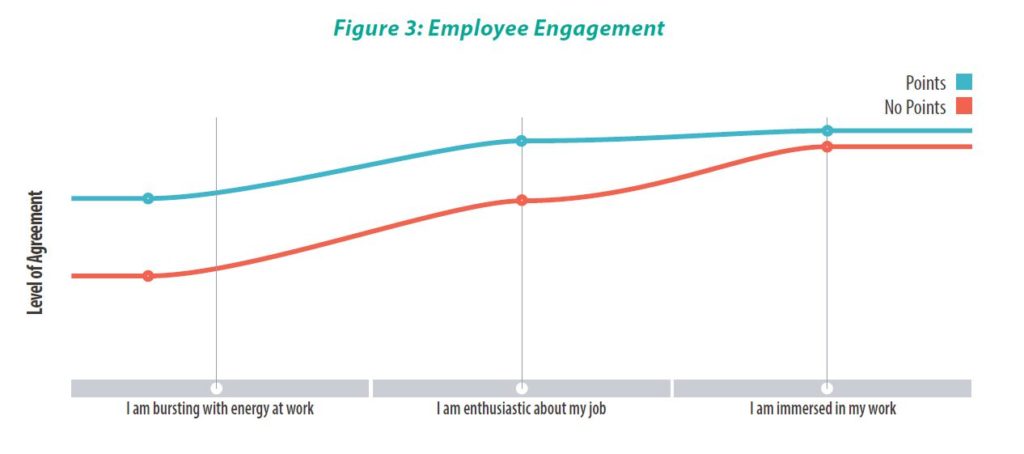
Perceptions of Points Programs: The Psychology of Points
Whether the reward is equal to cash or not misses the point; when you get appreciation from peers or managers, nothing can winnow that away, people will never get cynical about recognition.
— Expert IntervieweeWe next considered whether working for an organization that uses a points reward program is associated with respondents’ overall satisfaction with the rewards and recognition they receive and their preference to work for an employer that uses a redeemable points reward program. First, we found reported satisfaction with rewards and recognition received is greater for respondents who work for an organization with a points program than those who do not. Second, and not surprising, those who work for an organization that has a points program (vs, no points program) have a greater preference for working for an organization with a points program.
Overall, points programs appear to reach employees beyond a transactional level. Points earners, by and large, perceive their rewards as separate from compensation and more as ‘gifts of appreciation.’ A large majority of respondents agreed with the following statements (See Appendix A for additional findings related to the psychology of points):
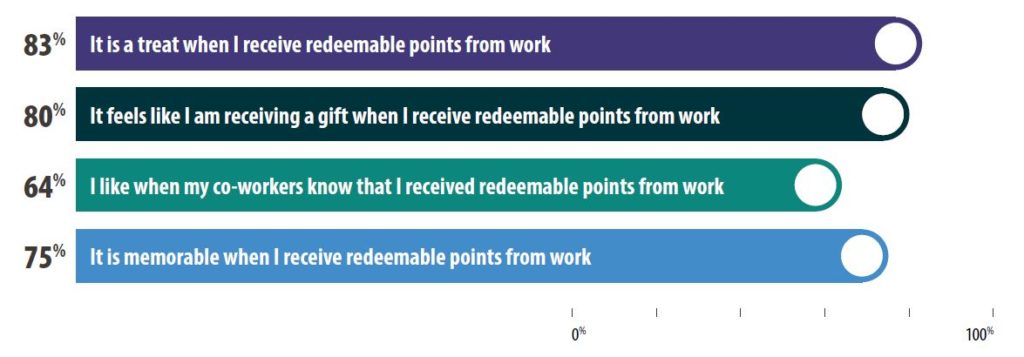
In behavioral science, there is the notion of medium maximization. People focus on the medium and will therefore focus on points to collect and grow them, and you can leverage that to keep them engaged. It makes it sticky.
— Expert IntervieweeThe science behind points program attractiveness draws from many aspects of psychology and behavioral science, yet our interviewees offered the most obvious explanations. Our experts speak to the wide scope of potential rewards and the numerous ways leaders from every part of an organization can leverage points programs to focus the power of recognition on their priorities. This near-unlimited opportunity for novelty overcomes people’s natural tendency to ‘habituation,’ which erodes pleasures over time, replacing them with feelings of entitlement.[vi] In these and other ways, firms control the marketing and messaging around points, which they cannot do for cash.
Many of our interviewees also described the more abstract-sounding notion that the reward itself does not matter as much as the recognition or the points themselves. In other words, whether a person collects points over time to redeem for a memorable experience like travel, or spends their points as they come on everyday things like light bulbs, the true benefit of points programs is that employees receive recognition (often twice – from a peer and a supervisor), followed by the reward of points which allows them to anticipate and plan for their reward. Finally, at least in most cases, they get a third or fourth lift from the reward itself.
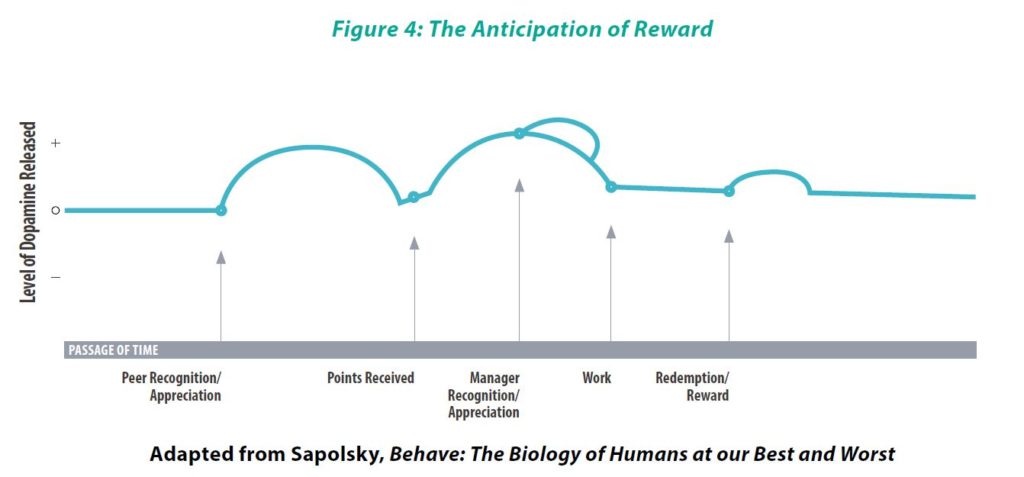
Though not specifically addressing points reward programs, Stanford neurobiologist Robert Sapolsky speaks to the “anticipation of reward” (Figure 4). Though the pleasure-inducing neurochemical dopamine wears off quickly as one habituates to a reward, it turns out that the anticipation of the reward does not. Sapolsky explains “Once reward contingencies are learned, dopamine is less about reward than about its anticipation … the pleasure is in the anticipation of reward, and the reward itself is nearly an afterthought (unless, of course, the reward fails to arrive, in which case it is the most important thing in the world).”[vii]
What was an unexpected pleasure yesterday is what we feel entitled to today, and what won’t be enough tomorrow.
— Robert SapolskyThis science supports our experts’ observations that it does not appear to matter a great deal when or for what a person redeems their points. The journey matters as much or more than the destination – the anticipation delivers the greater amount of dopamine and pleasure than the reward (Figure 4). Yet even Sapolsky may be surprised at human behavior in points reward programs. Several of our experts told us that a small but significant minority of people collect points forever, never redeeming them. For these individuals, the pleasure may always be in the anticipation (though if the potential for reward were removed, the anticipation would likely be lost as well). In any case, the psychology of anticipation presents a strong argument against expiring unused points or pushing too hard on individuals to use them. It also suggests that that firms should continue to find a variety of reasons to reward with points and use features such as leaderboards and recognition in combination with points.
Per our experts’ experience and Sapolsky’s science, points programs may provide a compound psychological effect. As discussed below, the incredible range of redemption options and uses associated with points programs keeps the experience novel, holding at bay the effects of habituation and entitlement. The anticipation of future reward spikes dopamine each time a person receives recognition and points (possibly twice), compounding the impact. Sapolsky tells us that anticipation requires learning. This helps explain why points may provide the “learning” that triggers anticipation of the reward to follow, thereby exciting the hippocampus and stimulating dopamine neurons.
The Utility of Points Programs: Platforms, Data and Flexibility
The results above suggest that organizations using employee points reward programs enjoy greater workforce motivation, engagement, and identification. While we cannot conclude that points rewards programs cause better motivation, engagement, loyalty, or identification, the correlations are strong and consistent. This should surprise no one. Greater recognition, appreciation, and reward should drive these outcomes. But compared to other forms of recognition and reward, are points-based programs a good choice? Our experts believe so for a variety of reasons.
Points reward programs are broad-based. A group travel incentive program, for example, might include only the firm’s top performers – perhaps 5%-10% at most due to high participant costs. Points reward programs often reach close to 100% of the workforce, making them more effective at motivating – and potentially improving – performance across a much larger group. Even small performance gains among 90% of an organization can dwarf larger ones from the top 10% alone.
Sending recognition helps build relationships. The beauty of a points program platform is it can remind people to do things. You can set it up so that notifications and reminders go out to managers and others to help them remember to recognize birthdays and other important milestones. Managers may have twenty reports these days, so peer-to-peer points programs help them see recognition ‘coming in’ and keep track of it. They can reach out and double the impact by asking a report about the peer recognition they received, congratulating them and increasing the impact, further building the relationship.
— Expert IntervieweePoints programs may also include an element of peer-to-peer recognition. When the giving of appreciation is restricted only to leaders and managers, impact is limited. Firms can scale recognition and embed the benefits into the culture by extending points recognition programs to employees themselves. Whether an employee recognizes a peer with a simple thank you, or by also attaching points rewards, more people give and receive appreciation more often. Points recognition platforms can capture this process, giving managers better insight into individual performance (and giving them the opportunity to recognize good work twice).
The range of reward redemption options in points rewards programs is virtually limitless. Points can be redeemed for merchandise, travel, gift cards, cash, time off, at-home meal delivery, and other personal services, even dog walking. Clever firms also offer company-branded clothing, mugs, and other ‘swag.’ Though an imperfect measure, where employees use their points to buy company-branded materials over comparable items, leaders can be reasonably certain that employees identify with the firm and are proud of their work.
If you have a new product launch and want the whole firm to know about it, you can use points accelerators to encourage people to do the training. Or if we’re close to a goal at the end of a quarter, we can use points accelerators to make it across the finish line. You can use points with the employee referral program. In fact, you can focus people with points for virtually anything. Some of our clients even run A/B tests with points to experiment with what works best.
— Expert IntervieweePoints programs and the platforms that drive them are flexible. They can be integrated with Human Resource Information Systems (HRIS), Enterprise Resource Platforms (ERP), and other workforce software such that any division or manager can build recognition and points into their initiatives. For example, where a new product has launched and a sales director wants her team to learn about it, she can assign points to the completion of a video or course about the new product (and even grant bonus points to those who get a perfect score on the course quiz). An HR leader who wants to promote employee referrals can use points accelerators to enhance cash rewards for referrals. A company wellness coordinator can reward employees who make healthier selections in the cafeteria. A production manager can use the system to promote workplace safety.
Our clients use points constantly to encourage countless actions and behaviors – that’s the flexibility of points programs (and why it’s so important to make them as broad-based and participatory as possible). The data they produce is massive, so you can use it to make the program continuously better, to see who’s using it more, and to correlate it to a wide variety of desired business outcomes. There are a thousand different ways to use the data for business intelligence and to improve decisions.
— Expert IntervieweeOur experts also cite the enormous data produced by points-rewards systems, especially when used on an enterprise-wide scale. Analysts can determine who is being recognized, for what and by whom, and which team, unit, or division leaders are regularly recognizing their people. Gradually, based on pattern recognition, a platform can motivate employees with rewards targeted specifically to their preferences. More importantly, analysts can link frequency of appreciation to important factors of employee engagement, retention, loyalty, and performance.
If you tie points and recognition to the core values of the firm, and then do accelerators per value from time to time – a core focus per month – you can even move the culture. But you have to keep reminding them, you want to build habits and systems.
— Expert IntervieweePoints Redemption
That dopamine shot of getting something is a good and fun thing, and you want people to feel it, so the more redemptions the better. We send out monthly communications through our platform to encourage frequent points redemption, but if they prefer to save them for something big, that’s ok too.
— Expert IntervieweeA substantial number of our survey respondents (79%) agree that they prefer to save their redeemable points to exchange for large-dollar item(s). However, a majority (58%) also agree that they frequently redeem points for small-dollar items. In fact, almost half of all respondents (49%) agree to both statements (Appendix A, Table 5). Most respondents like to redeem their points for hedonic and memorable items or experiences. A significant percentage, however, use them for utilitarian purchases (Appendix A, Table 4).

We are all motivated differently, but with points it doesn’t matter. If they hoard points, they are motivated toward the behaviors we award them for. If they spend them as they get them, they are motivated toward the behaviors we award them for.
— Expert IntervieweeConclusions & Recommendations
The results from our study support the limited research that finds points reward programs to be memorable and effective at motivating employees. Our study aligns with the latest behavioral science, which suggests unique compound benefits are achievable with points reward programs. Our experts’ own experience speaks to the efficacy of points reward programs in terms of motivation, flexible use, ‘moving the middle,’ and in learning from the data they produce. These findings lead to the conclusion that adding points rewards to a broader incentive and reward program is a wise choice. Our study offers practical guidance to managers and others who design and operate points reward programs, including the following and additional best practices in the supplemental report How to Run an Effective Points Program: 30+ Tips from the Experts.
Experience and past research show that offering points to sellers for performing at or above a target threshold can generate significant sales lift and ROI. This “move the middle” approach ensures that a performance improvement program reaches more than just the top 10%, whether they are sales or non-sales employees.
— Expert Interviewee- Offer sufficient budget to points rewards programs to make them meaningful. This is likely to cause employees to plan for their use. Thinking about their rewards and saving points to acquire something meaningful likely increases engagement and motivation.
- Include a broad range of points redemption options, even including cash-equivalent gift cards. The number of redemption options is positively associated with identification, engagement, and intrinsic motivation. The greater the choice, the more value participants will place on their points and the program in general. Include rewards that generate discussion amongst recipients and potential reward earners, including company-branded ‘swag.’ When a person talks about their reward, they create deeper, longer-lasting associations with the organization and more feelings of satisfaction with the reward. They also generate positive buzz about the reward program and the organization.
- Consider the advantages in data collection, reporting, and analysis that points-based reward programs deliver. Turn data analysis into insights to continuously improve your program and to build the business case for points by linking the program to improvements in employee engagement, retention, and performance.
Organizations that expire points to speed up redemption may be taking an unnecessary step that also restricts participants from feeling they can accumulate points, which a majority of participants prefer to do (Appendix A, Table 5). That said, those that prefer large rewards but still redeem for small rewards report higher organizational identification, engagement, and intrinsic motivation. Thus, it may be important to allow employees to feel as though they can accumulate points as they desire yet entice these individuals to redeem their points on small-dollar rewards.
You don’t want to leave a bad taste, that’s the opposite of what you intended with your points program. So tie the behavior to the reward, but if possible, never expire their points.
— Expert IntervieweeOne strategy that could drive employees to increase their redemption frequency without altering their preference for saving points for large-dollar items is including cash as a redeemable reward within the points system. Our evidence suggests that redemption for small-dollar items is higher when cash is an option than when it is not (Appendix A Figure 2). However, introducing cash as a redeemable reward risks making the points reward program less distinguishable from other cash earnings, and distinguishing point rewards from other earnings is positively associated with intrinsic motivation, identification, and engagement (Appendix A, Figure 3).
Appendix A: Additional Survey Findings – Points Earnings,Preferences and Redemption can be viewed in the downloadable PDF version of this study.
[1] Though our experts earn fees for designing (and, in many cases operating) points reward programs, they also offer a range of non-points-based incentive and reward programs. Points programs often deliver smaller margins that other incentive and reward program designs. Therefore, it is reasonable to conclude that even though our interviewees are biased toward reward and incentive programs in general, they are more or less agnostic on what type of reward program they deliver to their clients.
HALO is proud to support the release of The Psychology of Points as a Research Advocacy Partner.
Citations
[i] Yip, K. (2018) The Problem with Points-Based Rewards Systems. Blueboard. See: https://www.blueboard.com/blog/the-problem-with-points-based-rewards-systems
[ii] Nunes, J. & Drèze, X. (2006) Your Loyalty Program is Betraying You. Harvard Business Review. See: https://hbr.org/2006/04/your-loyalty-program-is-betraying-you
[iii] Patricia A. Norberg, Quinnipiac U. (2017). Employee Incentive Programs: Recipient Behaviors in Points, Cash, and Gift Card Programs. Performance Improvement Quarterly. 29 (4) 375-388
[iv] Alonzo V. (N.D.) The Trouble with Money. Proquest. Incentive New York, 10425195, Vol. 170, Issue 2
[v] Deci E. and Ryan R. (2008). Self-Determination Theory: A Macrotheory of Human Motivation, Development, and Health. Canadian Psychology. Vol. 49, No. 3, 182–185
[vi] Cooke, S. & Ramaswami, M. (2020) Ignoring the Innocuous: The Neural Mechanisms of Habituation. The Cognitive Neurosciences, 6th Edition, Ch.17. MIT Press
[vii] Sapolsky, R. (2018) Behave: The Biology of Humans at our Best and Worst. Penguin. P.69-72
Acknowledgements
The authors and the Incentive Research Foundation express their deep gratitude to the people and firms who helped guide this research, supplied data, and/or provided expert insights during in our interviews.
- Susan Adams, Next Level Performance
- Charlotte Blank, Maritz
- Mike Donnelly, Hinda Incentives
- Brian Dunne, Incentive Marketing Association
- Tanya Fish, ITA Group
- Joe Jones, Incenta Rewards
- Todd Keim, Motion Industries
- Jerry Klein, Jerry Klein Design
- Michael Litos, HALO
- Richard Low, Atlantic Incentives
- Mike McWilliams, Next Level Performance
- Jim Micklos, This is Fusion
- Cindy Mielke, Tango Card
- Richelle Suver, One10 Marketing
- Jeff Weiner, Collegis Education
- Maggie Wenthe, ITA Group
About The Authors
Aaron McCullough is a Ph.D student at the University of Central Florida
Adam Presslee is a professor of managerial accounting at the University of Waterloo
Allan Schweyer is the Chief Academic Advisor at the Incentive Research Foundation
Download The Report
